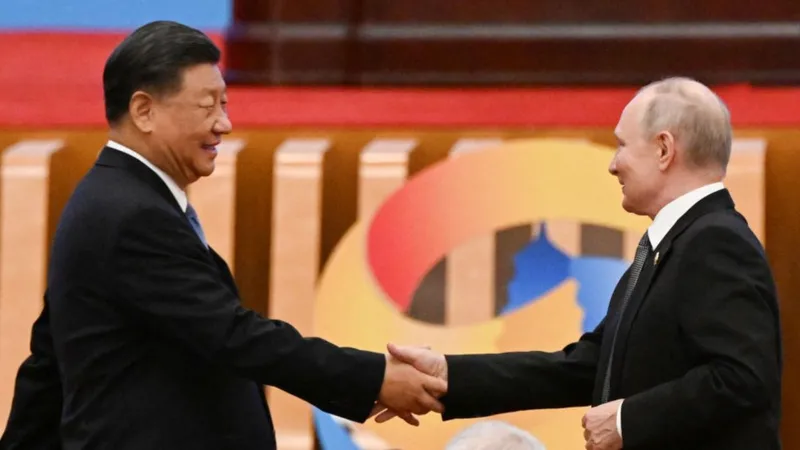How is China supporting Russia after it was sanctioned for Ukraine war?
Russian President Vladimir Putin is set to meet his Chinese counterpart Xi Jinping in Beijing this week.

This marks the Kremlin chief's second visit to China in seven months - and the fourth meeting between the two leaders since Russia invaded Ukraine in February 2022.
In that time, Beijing has become a vital partner for Moscow, as it seeks to soften the impact of sanctions imposed by the US and other countries.
Is China providing Russia with weapons?
China has repeatedly denied allegations that it supplies Russia with weapons.
In an interview with BBC News during last month's visit to Beijing, US Secretary of State Antony Blinken said: "What's not happening is the provision of actual arms by China to Russia for use in Ukraine."
However, China has been accused of building up Moscow's war machine by providing critical components.
Mr Blinken said: "Those are being used to help Russia on what's an extraordinary crash course effort to make more munitions, tanks, armoured vehicles, missiles."
About 70% of the machine tools and 90% of the microelectronics Russia imports come from China, he added.
China has not supplied Russia with weapons but is accused of supporting Moscow's defence industry
Sanctions announced by Washington in May targeted about 20 firms based in China and Hong Kong. It said one exported components for drones, while the others have allegedly assisted Moscow in bypassing Western sanctions on other technologies.
"There is evidence that China is the biggest exporter of semiconductors - often through shell companies in Hong Kong and the UAE - to Russia," Maria Shagina, of UK-based think tank the International Institute of Strategic Studies, said.
"Some Chinese companies are also supplying civilian drones, exploiting the grey space between military and civilian purposes."
China defends its trade with Moscow by saying it is not selling lethal arms and "prudently handles the export of dual-use items in accordance with laws and regulations". Beijing exports more than $300m worth of dual-use items - those that have both commercial and military applications - to Russia every month, according to an analysis of Chinese customs data by the think tank Carnegie Endowment. It says the list includes what the US has designated as "high priority" items, which are necessary for making weapons, from drones to tanks.
RUSI, a UK-based think tank has also cautioned about the potential use of Chinese satellite technology for intelligence on Ukraine's front line.
What are the sanctions on Russia and are they working?
China's war neutrality claim fades with Russia visit
Putin in China to strengthen anti-West coalition
How much has trade between China and Russia increased?
Beijing has become Moscow's key supplier of cars, clothing, raw materials and many other products, after Western countries imposed sanctions on Russia.
Trade between China and Russia reached a record $240bn (£191bn) in 2023, up more than 64% since 2021 - before Russia's invasion of Ukraine - according to official figures from China.
Russia's growing trade with China . in US$bn. Bar Chart showing Russia's growing trade with China from 2015 to 2023. .
Russian imports from China were $111bn and its exports to China $129bn, the figures show.
The export of Chinese cars and parts to Russia reached $23bn in 2023 - up from $6bn the previous year.
"Russian natural gas is fuelling numerous Chinese households, and Chinese-made automobiles are running on Russian roads," said China's Foreign Minister Wang Yi in March.
As Beijing boosts its electric vehicle industry domestically, Moscow has become a top destination for petrol models
However, some experts consider this a "lopsided" relationship in which Russia is more dependent on China than vice versa.
As of 2023, China has become Russia's top trade partner, while Russia is China's sixth-largest trade partner.
How much oil and gas does China buy from Russia?
Almost half of all the Russian government's annual revenues come from oil and gas.
Its sales to the US, UK and EU countries have plummeted since the invasion, because of sanctions.
Who is buying Russian oil and gas?
A significant amount of this shortfall has been made up with increased sales to Asia - in particular, China and India.
In 2023, Russia surpassed Saudi Arabia to become China's top crude oil supplier. Beijing imported 107 million tonnes of crude oil from Moscow - a 24% increase from 2022.
The G7 group of "advanced" economies, along with the European Union and Australia, has also tried to limit Russia earnings by imposing a worldwide cap on the price of its oil transported by sea.
However, China has continued to buy Russian crude at above the price of the cap.
Chinese imports of Russia oil and LPG (liquified petroleum gas). 2015 to 2023, millions of tonnes. .
India, which has continued to maintain its decades-old relationship with Russia, has also been a major buyer of its discounted oil since the invasion.
Russia's share of India's total oil imports hit a record high of 44% in June 2023, according to the Bank of Baroda, an Indian state-controlled lender.
In 2023, China also imported eight million tonnes of liquefied petroleum gas (LPG) from Russia, a 77% increase from 2021.
The two countries also plan to expand energy ties, including a new pipeline - called the Power of Siberia 2 - to export natural gas from Russia's western Siberia region to north-eastern China.
China already receives gas from Russia through the original Power of Siberia pipeline, which has been in use since 2019.
-bbc







